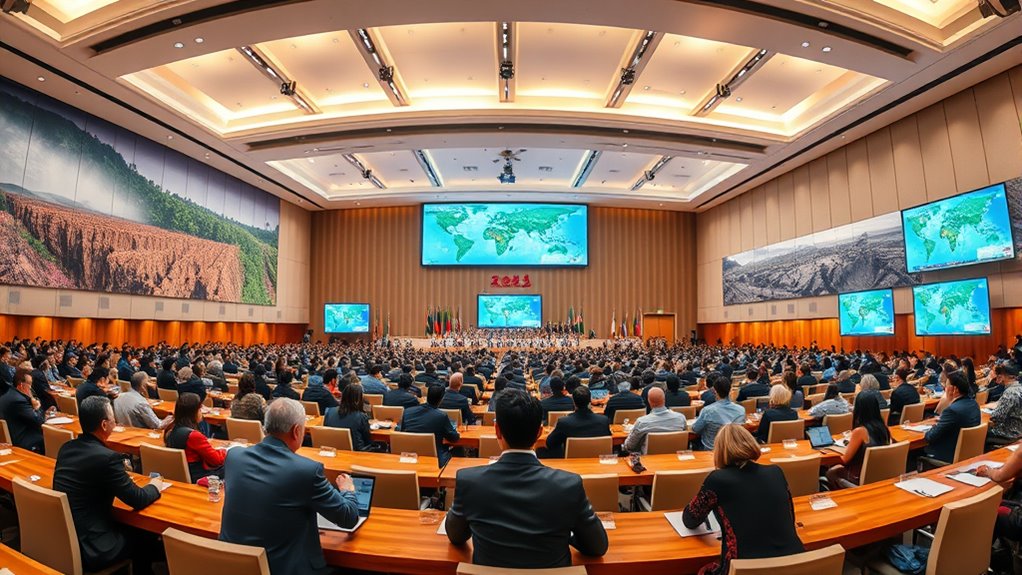Recent updates show significant progress in global biodiversity negotiations centered on the Montreal-Kunming framework. Countries are making stronger commitments to protect ecosystems, respect indigenous rights, and establish marine conservation areas. Efforts focus on creating effective strategies beyond protected zones, tackling issues like climate change and overfishing. This movement reflects a shared understanding of biodiversity’s social and economic importance. Keep exploring to discover how these advances are shaping the future of Earth’s life-support systems.
Key Takeaways
- Countries have committed to ambitious biodiversity targets, emphasizing marine conservation and indigenous rights within the Montreal-Kunming Framework.
- Progress includes establishing protected marine areas, promoting no-take zones, and integrating traditional knowledge into management plans.
- Negotiations recognize biodiversity as a social and economic issue, fostering broader international cooperation and funding strategies.
- Indigenous communities are increasingly involved in conservation efforts, ensuring rights-based approaches and traditional practices are honored.
- The framework reflects a holistic, interconnected strategy aimed at safeguarding global biodiversity for future generations.

Have you ever wondered how countries come together to protect our planet’s rich variety of life? The ongoing global biodiversity negotiations aim to do just that, creating frameworks that encourage nations to collaborate on conservation efforts. One of the key aspects gaining attention is how these agreements respect indigenous rights, recognizing that Indigenous peoples are often the best stewards of their lands and waters. Their traditional knowledge plays a crucial role in safeguarding biodiversity, especially in fragile ecosystems like rainforests and coastal areas. The negotiations emphasize that protecting biodiversity isn’t just about setting aside protected areas but also about ensuring indigenous communities have a say in how these spaces are managed. This approach promotes a more inclusive model, acknowledging their rights and contributions, which ultimately leads to more effective conservation outcomes.
Marine conservation is another critical focus within these negotiations. Oceans cover over 70% of the Earth’s surface, yet they face mounting threats from overfishing, pollution, and climate change. Countries are increasingly recognizing that protecting marine biodiversity requires international cooperation. The negotiations aim to establish stronger commitments to conserve marine habitats, establish no-take zones, and regulate fishing practices. These measures are essential to maintain healthy marine populations, which are indispensable for global food security and climate regulation. By fostering cooperation among nations, the framework seeks to create a resilient network of marine protected areas that transcend national borders. This will ensure that marine species, from corals to whales, have safe spaces to thrive, even amid changing ocean conditions. Additionally, recognizing the importance of biodiversity in maintaining ecological resilience underscores the interconnectedness of these efforts.
Progress is evident in the commitments made during recent negotiations, with many countries agreeing to ambitious targets. They acknowledge that protecting biodiversity isn’t just an environmental issue but a social and economic one as well. Incorporating indigenous rights into the framework underscores a recognition that local communities are essential partners in conservation. Likewise, a focus on marine conservation reflects an understanding that oceans are interconnected, requiring global strategies. While challenges remain—such as ensuring adequate funding and enforcement—the momentum is promising. Countries are increasingly aware that their actions today will shape the future of life on Earth. As a participant in these negotiations, you can see that these efforts are about more than policies—they’re about safeguarding a shared planet for generations to come.
Frequently Asked Questions
How Will the Framework Impact Local Communities and Indigenous Peoples?
The framework aims to strengthen indigenous rights and promote community empowerment by involving local communities in conservation efforts. You’ll see more opportunities for indigenous peoples to lead initiatives, ensuring their knowledge is respected and integrated. This approach helps protect biodiversity while honoring traditional practices. As a result, local communities can benefit economically and socially, fostering sustainable development and resilience in their environments.
What Are the Specific Financial Commitments Made by Countries?
You’ll see countries make significant funding commitments, including financial pledges aimed at supporting biodiversity initiatives. These funding commitments are designed to mobilize resources for conservation efforts, protect ecosystems, and benefit local communities. Countries have pledged billions to guarantee sustainable use of biodiversity, with some promising specific financial pledges over the next decade. Your involvement helps guarantee these commitments translate into real actions that safeguard nature and support those most affected.
How Will Progress Be Monitored and Enforced Globally?
You’ll see progress monitored through robust mechanisms like regular reporting, independent reviews, and digital platforms tracking biodiversity goals. Enforcement strategies include binding commitments, peer accountability, and potential sanctions for non-compliance. These monitoring mechanisms guarantee transparency, while enforcement strategies hold countries responsible for their biodiversity targets. By actively participating and adhering to these systems, you help create a global effort that promotes accountability and drives real progress in conserving biodiversity worldwide.
What Role Do Private Sectors and NGOS Play in These Negotiations?
Imagine a vibrant mosaic of efforts—private sectors and NGOs shape global biodiversity by forging corporate partnerships and leading NGO advocacy. You see corporations investing in sustainable practices, while NGOs rallying international support, amplifying voices for change. Their collaboration drives policy, raises awareness, and holds governments accountable. You become part of this movement, where combined influence accelerates progress, demonstrating that collective action from private sectors and NGOs is essential for meaningful biodiversity conservation.
How Does the Framework Address Emerging Environmental Challenges?
The framework tackles emerging environmental challenges by encouraging the adoption of technological innovations and promoting policy integration across sectors. You’re guided to leverage new tools like remote sensing or AI for better biodiversity monitoring and develop cohesive policies that align environmental goals with economic growth. This approach helps anticipate and address unforeseen threats, ensuring your efforts are adaptable and effective in safeguarding biodiversity amid changing global conditions.
Conclusion
You’ve seen how global biodiversity negotiations are making monumental strides with the Montreal‑Kunming framework, turning ambitious goals into real action. It’s like witnessing a seismic shift in our planet’s future—nothing less! Keep hope alive because your voice and support can fuel this incredible movement. Together, we’re not just saving species; we’re shaping a future so vibrant and resilient, it’ll outshine even the brightest stars. The world’s biodiversity renaissance is just getting started—brace yourself for the extraordinary!









